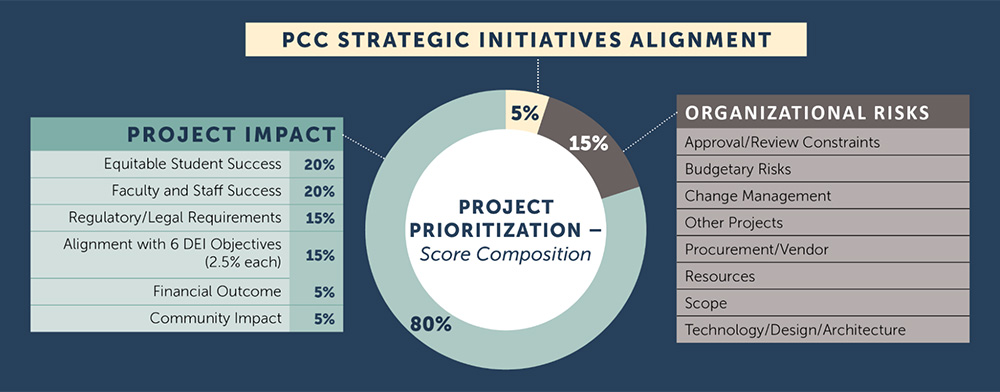The strategic planning process
From September 2019 to November 2020, Portland Community College developed a new strategic plan with a five-to-ten-year vision. With leaders throughout the college, as well as faculty, staff, and students leading the way, PCC embarked upon a strategic planning journey in August of 2019. From the very beginning, our Strategic Planning Steering Committee pledged to lead a strategic planning process that placed equity at its center and was inclusive, transparent, forward-thinking, and data-informed. Over 1,600 faculty, staff, and students have been involved with the planning process through numerous town hall sessions, focus groups, surveys, and deep-dives into internal and external environmental data. In the midst of our strategic planning process, the global COVID-19 crisis made us even more aware of how critical it is for PCC to make innovative and adaptable plans for the future of education. We had to quickly pivot to primarily online and remote operations while continuing to serve students and the community. Despite all the challenges that faced us, from COVID-19 to wildfires to racial injustice, we continued to plan for the future.
These efforts produced four strategic areas of focus, twenty Board-approved initiatives, and thirty-seven strategic planning projects, all of which form PCC’s 2020-2025 Strategic Plan. This plan provides both the foundation and the roadmap to fulfilling our mission, transforming the lives of our students, and serving the needs of our community, well into the future.
From the 20 initiatives, projects were developed by Cabinet Sponsors and the project managers they identified. The leaders for each of the projects developed a project proposal, which was reviewed by key stakeholders. Using the data input by each project manager, the project and portfolio management program generated a preliminary priority score. The greatest emphasis and weight in the calculation was given to the impact on equitable student success as well as faculty and staff success.

Description of the graphic
- The prioritization score is made of three elements:
- Benefits (or project impact) make up 80% of the score. Within that score:
- Equitable student success: 20%
- Faculty and staff success: 20%
- Regulatory and legal requirements: 15%
- Alignment with the six DEI objectives: 15% (2.5% each)
- Financial outcome: 5%
- Community impact: 5%
- Organizational risks have an inverse relationship with the score: the higher the risk, the lower the points. Each of the eight risk factors is scaled from low to high, and the total of these eight risks makes up 15% of the score:
- Approval and review of constraints
- Budgetary risks
- Change management
- Other projects
- Procurement and vendor
- Resources
- Scope
- Technology, design, and architecture
- Strategic initiative alignment: 5% of the score
- Benefits (or project impact) make up 80% of the score. Within that score:
Cabinet adjusted the preliminary priority scores based on seven factors, as well as alignment with the college’s equity objectives.
- Equitable student success: Is it likely to close equity gaps and improve student outcomes? Is the project aligned with equitable student success and social justice values and goals?
- Faculty and staff success: Is it likely to improve employee outcomes such as retention, sense of belonging, productivity, and an increased sense of professional growth? Does it have a broad reach within employee group(s)?
- Regulatory and legal requirements: Is it likely to strengthen the college’s ability to be in compliance with regulatory and legal requirements?
- Financial (cost savings and/or revenue generation): Is it likely to generate increased and sustained revenue and cost-saving streams for the college? Does it address historical infrastructure and resource gaps?
- Community impact: Is it likely to strengthen or develop the college’s position as a leader in higher education and as a trusted workforce and community partner, regionally and nationally?
- Factors not included in the scoring: What are the factors that may contribute to the importance of the project that haven’t been addressed in the data input by project managers?
- External factors: What factors outside of PCC’s control impact the college and drive the need for these projects, such as changing laws, climate change, sustainability, supply chain issues, and others?
After further review, Cabinet reviewed and adjusted the prioritized list of projects and aligned them with the budget. To kick off the efforts, 10 projects were approved to move forward with funding with strategic investment funds.
